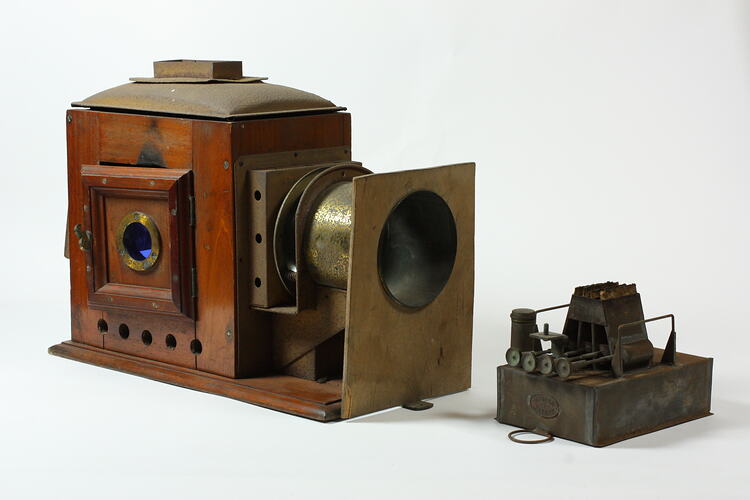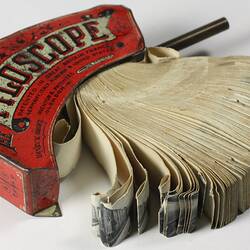Summary
Incomplete mahogany and brass projector used to view lantern slides. The maker of the lantern is unknown. The slide-out illuminant is a Stocks' Patent 4-wick illuminant. The Englishman Walter Stocks patented a number of different types of magic lantern illuminant, as well as magic lanterns in the late 19th century.
While the invention of the magic lantern is generally seen to be in the 17th century, its greatest popularity as an optical projector spans the late 18th century to the early decades of the 20th century. It was used both as a means of entertainment and education.
This lantern projector is part of the Francis Collection of pre-cinematic apparatus and ephemera, acquired by the Australian and Victorian Governments in 1975. David Francis was the curator of the National Film and Sound Archive of the British Film Institute as well as being a co-founder of the Museum of the Moving Image in London, which was operational between 1988 and 1999.
Physical Description
Rectangular wooden body. Corroded metal top and condenser lens housing. Rectangular aperture in roof. Brass outer tube and lantern body detailing. Flat wooden front at outer tube. Missing objective lens. Ventilation holes (x3) each side of rectangular condenser lens housing. Ventilation holes (x5) along bottom margin each lateral side. Hinged and latched wooden door on right lateral side with metal lined interior. Door has large blue glass viewing aperture surrounded by brass margin. Hinged 3/4 flip door at back of lantern body, interior metal lined. Illumination chamber metal lined on interior. Removable condenser lens in situ. Slide out 4-wick oil illuminant. Oval name plaque on back of illuminant.
More Information
-
Collection Names
-
Collecting Areas
-
Acquisition Information
Loan & Subsequent Donation from Australian Film Institute (AFI), Mr David Francis, by Nov 1990
-
Collector
Mr David Francis, London, Middlesex, England, Great Britain, 1990
-
Manufacturer of Component
-
Inscriptions
On circular paper sticker on back door: '495' On oval plaque on the back of illuminant: 'STOCKS/PATENT'
-
Classification
Communications, Audio-visual technology, Image production equipment
-
Category
-
Discipline
-
Type of item
-
Overall Dimensions
437 mm (Length), 190 mm (Width), 290 mm (Height)
-
References
[Book] Robinson, David, et al. 2001. Encyclopaedia of the Magic Lantern., 294 Pages
-
Keywords
Lantern Projectors, Magic Lanterns, Pre-Cinema Moving Images, Projectors

